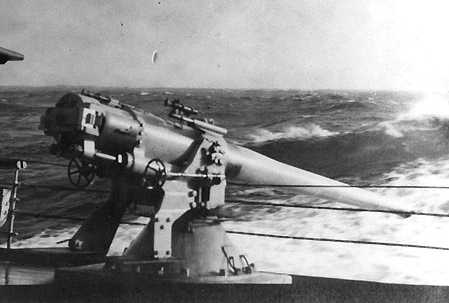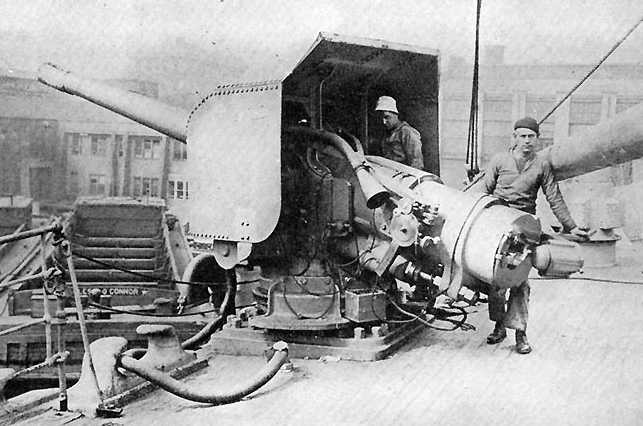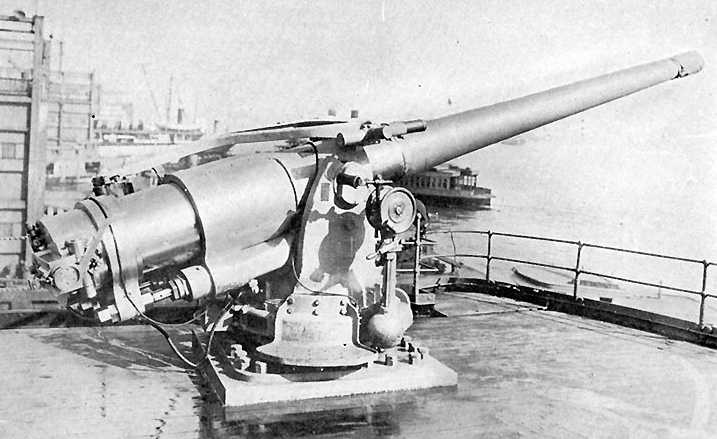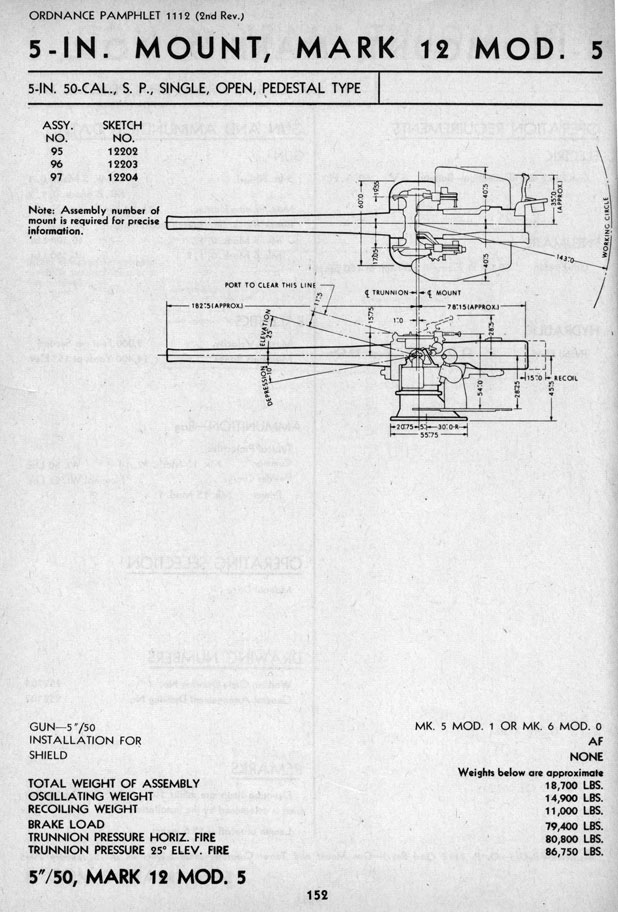
This was the first USN long-barrel 5-inch (12.7 cm) gun and was used as the secondary battery on battleships and cruisers in the early part of the twentieth century. It was considered to be an interim design and was later replaced on new construction by the more powerful 5"/51 (12.7 cm).
During World War II, these guns were used to arm some cargo ships, store ships and unclassified auxiliaries (IX). They were also used in emergency coastal defense batteries.
The Mark 5 was a built-up gun while the Mark 6 was to a simpler design, replacing the earlier gun's jacket, chase hoop and locking ring with a single jacket. Both Marks used a side-swinging Welin breech block with Vickers breech mechanisms.
| Designation | 5"/50 (12.7 cm) Marks 5 and 6 |
|---|---|
| Ship Class Used On | Delaware (B-28), Denver (C-14) and Chester (CS-1) classes
New York (ACR-2) 1 and New Orleans (CL-22) classes as rearmed |
| Date Of Design | about 1900 |
| Date In Service | 1904 |
| Gun Weight | N/A |
| Gun Length oa | N/A |
| Bore Length | 250 in (6.350 m) |
| Rifling Length | N/A |
| Grooves | N/A |
| Lands | N/A |
| Twist | Mark 5: Increasing RH 0 to 1 in 25 at the muzzle
Mark 6: Uniform RH 1 in 25 |
| Chamber Volume | N/A |
| Rate Of Fire | about 6 - 8 rounds per minute |
- ^New York (ACR-2) was rearmed with Mark 6 guns. I lack data as to which Mark was used for other warships.
| Type | Bag |
|---|---|
| Projectile Types and Weights 1a | AP: 50 lbs. (22.7 kg)
AP: 60 lbs. (27.2 kg) Common Mark 15 Mods 1 through 14 2a: 50 lbs. (22.7 kg) |
| Bursting Charge | AP: 1.7 lbs. (0.77 kg)
Common Mark 15: 1.73 lbs. (0.78 kg) |
| Projectile Length | AP: N/A
Common Mark 15 Mods 12 and 14: 17.0 in (43.2 cm) |
| Propellant Charge | For 50 lbs. (22.7 kg) shells: 21.0 lbs (9.5 kg) SPD or SPDN
For 60 lbs. (27.2 kg) shells: 19.2 lbs (8.5 kg) SPD |
| Muzzle Velocity | For 50 lbs. (22.7 kg): 3,000 fps (914 mps)
For 60 lbs. (27.2 kg): 2,700 fps (823 mps) |
| Working Pressure | For 50 lbs. (22.7 kg): N/A
For 60 lbs. (27.2 kg): 16.5 tons/in2 (2,600 kg/cm2) |
| Approximate Barrel Life | N/A |
| Ammunition stowage per gun | Delaware: 240 rounds
Others: N/A |
| Elevation | Range |
|---|---|
| 25.3 degrees
Probably for a MV of 3,000 fps (914 mps) |
19,000 yards (17,370 m) |
| Designation | Pedestal Mount
Delaware (14): Marks 9 1b and 12 2b Denver (10): N/A Chester (2): N/A New York (10): N/A New Orleans (10): N/A |
|---|---|
| Weight | Mark 9: 20,400 lbs. (9,253 kg)
Mark 12: 18,700 lbs. (8,482 kg) |
| Elevation | Mark 9: -10 / +15 degrees
Mark 12: -10 / +25 degrees |
| Elevation Rate | Manual operation, only |
| Train | about +150 / -150 degrees |
| Train Rate | Manual operation, only |
| Gun recoil | 15 in (38 cm) |






"US Naval Weapons", "US Battleships: An Illustrated Design History" and "US Cruisers: An Illustrated Design History" all by Norman Friedman
"U.S. Explosive Ordnance: Ordnance Pamphlet 1664 - May 1947" by Department of the Navy
17 August 2006 - Benchmark
18 May 2015 - Redid photograph of USS North Dakota
16 January 2019 - Converted to HTML 5 format, reorganized notes and added mounting sketch
